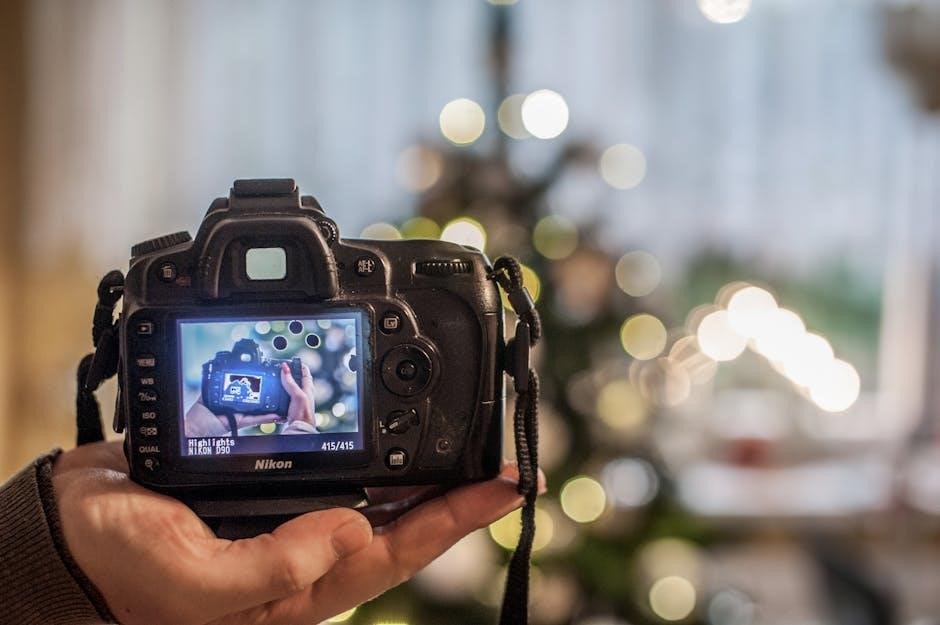
manual for nikon d3300 camera
The Nikon D3300 is an entry-level DSLR camera featuring a 24.2MP CMOS sensor and EXPEED 4 image processor. Designed for beginners and enthusiasts, it offers manual controls, HD video recording, and a user-friendly interface. The camera is ideal for those seeking high-quality images and ease of use, with detailed guidance provided in its comprehensive manual.
1.1 Key Features of the Nikon D3300
The Nikon D3300 features a 24.2MP CMOS sensor, EXPEED 4 image processor, and 11-point autofocus system for sharp, detailed images. It supports 1080p HD video recording, ISO sensitivity up to 12800, and a 3-inch LCD screen. The camera includes an 18-55mm VR lens for versatility and offers manual focusing options, catering to both beginners and enthusiasts seeking creative control.
1.2 Design and Build Quality
The Nikon D3300 features a lightweight and compact design with a durable plastic body, providing a comfortable grip for easy handling. Weighing just 410g, it is portable and user-friendly. The camera includes a 3-inch LCD screen and a single command dial, making it intuitive for beginners while maintaining essential controls for creative photography.
1.3 Target Audience
The Nikon D3300 is designed for hobbyists and entry-level photographers seeking a balance between quality and affordability. Its intuitive interface and manual controls make it ideal for those transitioning from compact cameras to DSLRs. Additionally, its portability and user-friendly features appeal to casual shooters and photography students looking to enhance their creative skills.
Getting Started with the Nikon D3300
The Nikon D3300 is a user-friendly DSLR designed for newcomers. Start by unpacking, charging, and inserting the memory card. Familiarize yourself with the camera’s layout and basic controls, then explore the menu system to customize settings and optimize performance for your photography needs.
2.1 Unboxing and Initial Setup
Unboxing the Nikon D3300 reveals the camera body, 18-55mm lens, rechargeable battery, charger, USB cable, and neck strap. Begin by attaching the lens, ensuring it clicks securely. Charge the battery fully before first use. Insert the memory card into the slot on the right side. Power on the camera and follow the on-screen prompts to set language, date, and time. Familiarize yourself with the camera’s buttons and dials. Finally, refer to the manual for initial firmware checks and updates to ensure optimal performance.
2.2 Charging the Battery and Inserting the Memory Card
Charge the Nikon D3300’s battery using the provided charger until the indicator turns green. Insert the battery into the camera’s bottom compartment, ensuring it clicks securely. For the memory card, open the slot on the right side, align the card with the arrows facing inward, and push gently until it locks. Always use a compatible SD/SDHC card and refer to the manual for specific guidelines.
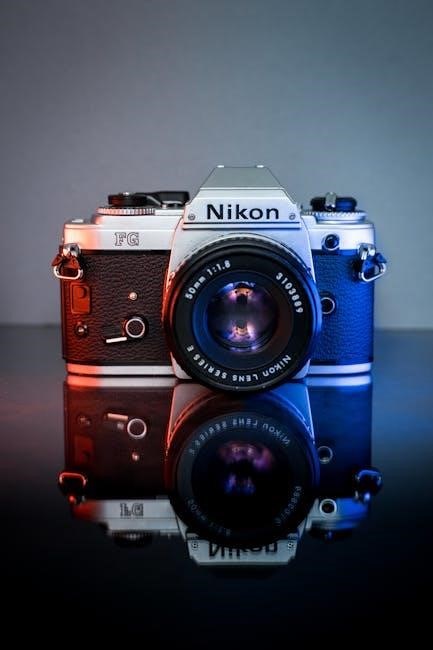
Shooting Modes
The Nikon D3300 offers various shooting modes, including Auto, Scene, Semi-Automatic (P, A, S, M), and Manual, catering to both beginners and advanced photographers for diverse photography needs.
3.1 Auto Mode
In Auto Mode, the Nikon D3300 automatically adjusts settings like aperture, shutter speed, and ISO for effortless photography. Ideal for beginners, it simplifies capturing sharp, well-exposed images. The camera’s 24.2MP sensor and EXPEED 4 processor ensure high-quality results, while the manual highlights how Auto Mode streamlines the process, allowing users to focus on composition and creativity without manual adjustments.
3.2 Scene Modes
The Nikon D3300 offers various Scene Modes, such as Portrait, Landscape, Night Portrait, and Close-up, to optimize settings for specific shooting scenarios. These modes automatically adjust aperture, shutter speed, and ISO for ideal results. Users can easily select modes via the camera’s interface, simplifying photography and enhancing creativity for both beginners and experienced shooters.
3.3 Semi-Automatic Modes (P, A/Av, S/Tv, M)
The Nikon D3300 offers semi-automatic modes: Program Auto (P), Aperture Priority (A/Av), Shutter Priority (S/Tv), and Manual (M). These modes allow users to control specific settings while the camera adjusts others, offering flexibility and creativity. Program Auto provides balanced settings, while Aperture and Shutter Priority enable control over depth of field and motion, respectively. Manual mode offers full control for advanced shooters.
3.4 Manual Mode
Manual Mode (M) on the Nikon D3300 offers full control over aperture, shutter speed, and ISO settings, enabling precise adjustments for creative photography. This mode is ideal for experienced users who want to customize every aspect of their shots. The camera’s manual focusing option ensures sharp images, while the silent wave motor provides quiet AF operation, enhancing overall performance and image quality.
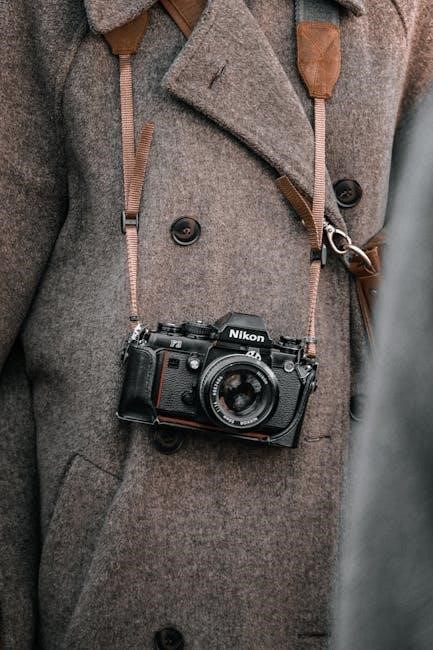
Autofocus System
The Nikon D3300 features an 11-point autofocus system, delivering fast and precise focus acquisition. It ensures sharp imagery with minimal effort, even in dynamic shooting conditions.
4.1 Autofocus Modes
The Nikon D3300 offers multiple autofocus modes, including Single Shot AF, Continuous AF, and Manual Focus. These modes cater to different shooting scenarios, providing flexibility and control over focus acquisition.
4.2 Autofocus Custom Settings
The Nikon D3300 allows customization of autofocus settings to enhance performance. Users can adjust AF mode priorities, focus area selection, and tracking sensitivity. These settings enable precise control over autofocus behavior, optimizing results for various photography styles and subjects.
4.3 Focus Area Selection
The Nikon D3300 offers 11 focus points, allowing users to manually select focus areas for precise control. This feature is particularly useful for portraits, wildlife, and action photography, ensuring sharp focus on the desired subject. The camera’s intuitive interface makes it easy to switch between focus points, enhancing overall shooting efficiency and accuracy.
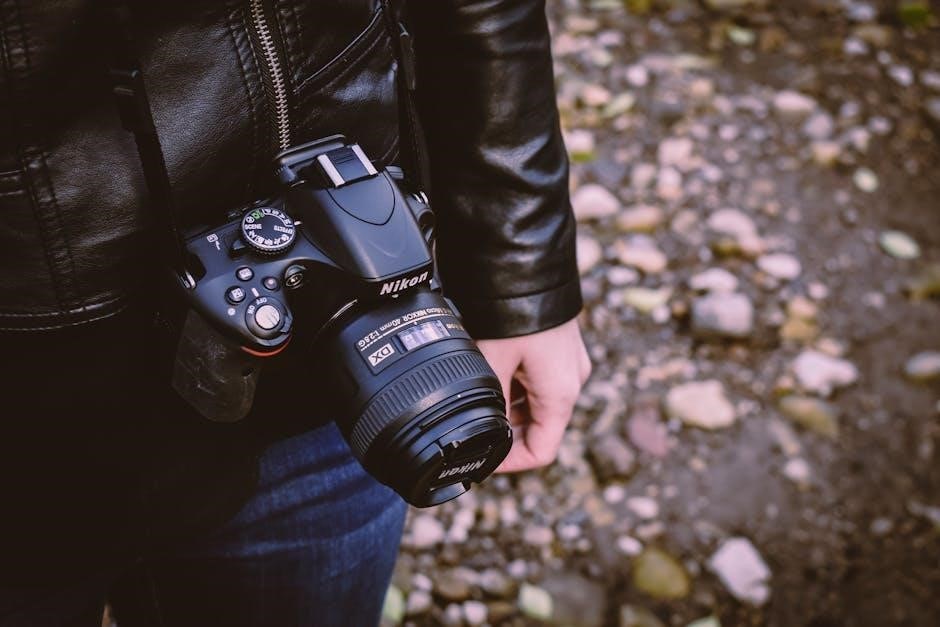
ISO and Noise Performance
The Nikon D3300 features an ISO range of 100-25600, delivering excellent low-light performance. The EXPEED 4 processor minimizes noise, ensuring crisp images even at higher sensitivities.
5.1 Understanding ISO Sensitivity
The Nikon D3300 offers an ISO range of 100-25600, enabling flexible shooting in various lighting conditions. Lower ISOs (100-800) are ideal for bright environments, while higher ISOs (1600-25600) are suited for low-light situations. The EXPEED 4 processor helps minimize noise, ensuring clearer images even at higher sensitivities. Adjusting ISO via the menu or external controls allows for precise control over image quality and noise levels.
5.2 Managing Noise in Low-Light Conditions
In low-light conditions, the Nikon D3300’s EXPEED 4 processor minimizes noise, delivering clearer images. Using lower ISO settings (100-1600) reduces grain, while the camera’s noise reduction feature further refines results. For optimal performance, shoot in RAW format and use noise reduction software during post-processing. A tripod or external flash can also help stabilize shots and reduce noise in dimly lit environments.
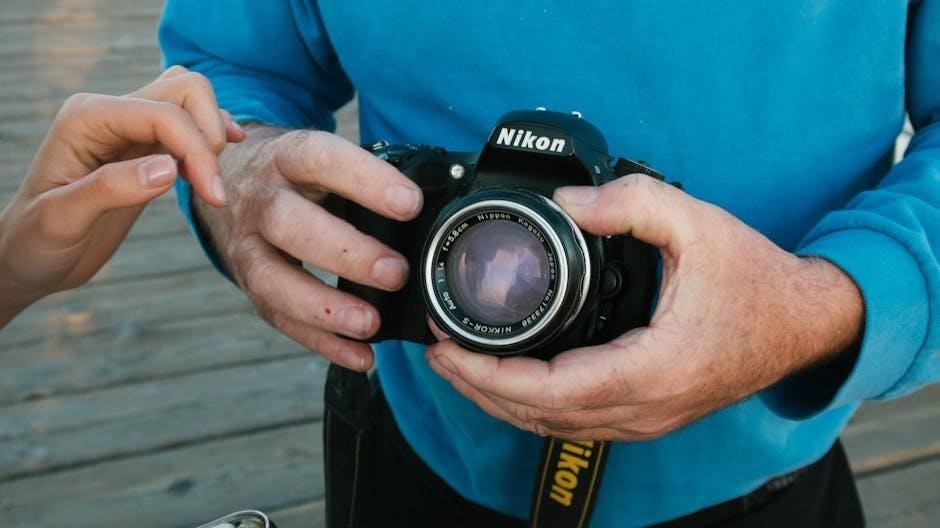
Metering and Exposure Control
The Nikon D3300 offers metering modes like Matrix, Center-weighted, and Spot to ensure balanced exposures. Exposure compensation allows adjustments for brighter or darker results, enhancing image control.
6.1 Metering Modes
The Nikon D3300 features three metering modes: Matrix, Center-weighted, and Spot. Matrix metering analyzes the entire scene for balanced exposure. Center-weighted prioritizes the central area, ideal for portraits. Spot metering measures a specific point, useful for high-contrast lighting. Each mode ensures accurate exposure, catering to different shooting scenarios and photographer preferences.
6.2 Exposure Compensation
Exposure compensation allows adjusting image brightness by ±5 EV in 1/3-stop increments. Press the exposure compensation button and turn the command dial to set. This feature affects both the LCD preview and final image, enabling precise control over lighting conditions. It works in all shooting modes, including Manual, where it complements aperture and shutter speed adjustments.

White Balance and Color Accuracy
The Nikon D3300 offers multiple white balance modes, including Auto, Preset, and custom options, ensuring accurate color representation. Fine-tuning settings allows photographers to capture true-to-life colors effectively.
7.1 White Balance Modes
The Nikon D3300 offers various white balance modes, including Auto, Preset, and custom settings. Auto mode adjusts colors based on lighting conditions, while Preset options like Daylight, Fluorescent, and Cloudy provide precise color accuracy. Custom white balance allows users to set specific conditions, ensuring consistent and accurate color representation in diverse shooting environments.
7.2 Custom White Balance
Custom white balance on the Nikon D3300 enables precise color control by capturing a reference image of a neutral object under the current lighting. This setting ensures accurate color reproduction in unusual or mixed lighting conditions, allowing for professional-grade results with minimal post-processing, as detailed in the manual for optimal customization.
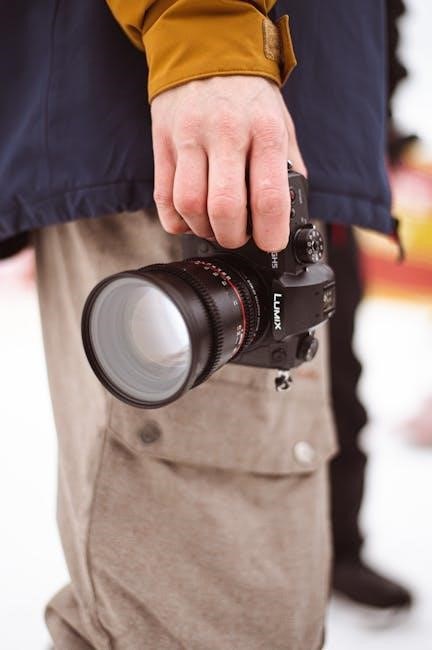
Image Quality and File Formats
The Nikon D3300 captures high-resolution images with its 24.2MP sensor, supporting RAW and JPEG formats. It also offers compression options for optimizing file sizes and quality.
8.1 Image Quality Settings
The Nikon D3300 offers customizable image quality settings, enabling users to adjust resolution, compression, and color modes. It supports RAW and JPEG formats, allowing photographers to balance file size and detail. The camera also provides options for fine-tuning sharpness, contrast, and color saturation, ensuring optimal results tailored to individual preferences and shooting conditions.
8.2 RAW vs. JPEG
The Nikon D3300 captures images in both RAW and JPEG formats. RAW files retain maximum detail for post-processing, offering greater flexibility. JPEG files are smaller, processed in-camera, and ready for immediate use. Choosing between them depends on your needs: RAW for professional editing, JPEG for convenience and faster workflow.
8.3 Compression Formats
The Nikon D3300 supports both RAW (NEF) and JPEG formats. RAW files are uncompressed, retaining all image data for editing. JPEG files are compressed, reducing file size but losing some detail. The camera also offers Fine, Normal, and Basic JPEG compression levels, balancing quality and storage needs. This flexibility suits various workflows and storage preferences.
Flash and External Lighting
The Nikon D3300 features a built-in flash for added illumination in low-light conditions. It also supports external flash units, enhancing lighting control and photo quality in various scenarios.
9.1 Built-In Flash
The Nikon D3300’s built-in flash provides convenient lighting for low-light situations. It automatically pops up and fires when needed, offering balanced illumination; The flash covers a wide angle and supports Nikon’s i-TTL flash control system, ensuring accurate exposure. Users can adjust flash settings via the camera menu, allowing for customization to suit various shooting conditions effectively.
9.2 External Flash Units
The Nikon D3300 supports external flash units for enhanced lighting control. Compatible with Nikon Speedlights, these flashes offer advanced features like wireless operation and TTL metering. Users can manually adjust flash power and sync settings via the camera menu, enabling precise control over lighting conditions for professional-grade photography results, as detailed in the Nikon D3300 manual.
Video Recording
The Nikon D3300 records Full HD video at 1080p with frame rates up to 60fps. Manual focus and audio settings ensure high-quality video capture, as detailed in the manual.
10.1 Video Mode Overview
The Nikon D3300 offers Full HD video recording at 1080p resolution, with frame rates up to 60fps. It supports manual focus and exposure control for creative flexibility. The camera also features a dedicated video mode, accessible via the mode dial, allowing users to capture high-quality footage with ease. The manual provides detailed guidance on settings and techniques for optimal video recording.
10.2 Resolution and Frame Rates
The Nikon D3300 captures video in Full HD (1080p) at frame rates of 60, 50, 30, 25, or 24fps. It also supports 720p resolution at 60fps for smoother motion. These settings allow users to tailor video capture to their creative needs, with detailed instructions provided in the manual for optimizing resolution and frame rate selections during recording.
10.3 Stabilization and Audio Settings
The Nikon D3300 lacks built-in image stabilization but supports VR (Vibration Reduction) lenses for smoother video. Audio settings include a built-in monaural microphone and compatibility with external microphones. The manual details how to enable wind noise reduction and adjust audio levels manually, enhancing sound quality during video recording for professional-grade results.
Menu Navigation
The Nikon D3300’s menu system is intuitive, offering easy access to settings like ISO, white balance, and autofocus. The Manual Viewer app provides on-the-go guidance.
11.1 Main Menu Overview
The Nikon D3300’s main menu is user-friendly, offering easy access to shooting settings, image quality adjustments, and camera customization. Key sections include Shooting, Setup, and Retouch menus. The menu allows customization of controls and provides options like image sensor cleaning. Designed for intuitive navigation, it helps users quickly adjust settings for optimal photography results.
11.2 Customizing the Menu
The Nikon D3300 allows users to customize the menu to suit their preferences. You can add frequently used settings to the “My Menu” section for quick access. Additionally, menu items can be rearranged or hidden to streamline navigation. This feature enhances efficiency and provides a more personalized shooting experience, catering to individual needs and workflows.
Troubleshooting and Maintenance
Common issues like error messages or sensor dust can be resolved by cleaning the sensor or updating firmware. Regular maintenance ensures optimal performance and longevity of the camera.
12.1 Common Issues and Solutions
Common issues with the Nikon D3300 include sensor dust, error messages, and autofocus malfunctions. Solutions involve cleaning the sensor, updating firmware to the latest versions like C-1.02 and L-2.018, and resetting camera settings. These steps ensure the camera operates smoothly and maintains image quality. Regular maintenance and updates are crucial for optimal functionality.
12.2 Cleaning the Sensor and Lens
Clean the sensor using the built-in “Clean Image Sensor” option in the setup menu. For manual cleaning, use a soft brush or swabs with cleaning solution. The lens should be wiped with a microfiber cloth and avoided harsh chemicals. Regular cleaning prevents dust spots and ensures sharp images. Refer to the manual for detailed steps to maintain optimal camera performance.
The Nikon D3300 is a versatile and user-friendly DSLR camera, ideal for capturing high-quality images and videos. With its robust features and intuitive interface, it caters to both beginners and enthusiasts. The comprehensive manual ensures mastery of its functions, enabling photographers to explore their creativity and achieve professional results. Referencing the guide regularly will enhance your shooting experience and help you make the most of this powerful tool.